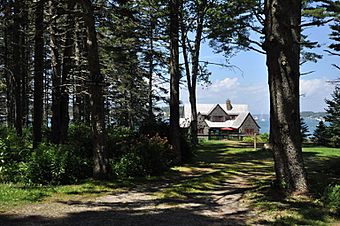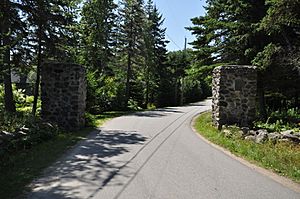Land's End Historic District facts for kids
Quick facts for kids |
|
|
Land's End Historic District
|
|
 |
|
| Location | Marshall Point & Cottage Rds., Lentine & Land's End Lns., St. George, Maine |
|---|---|
| Area | 45 acres (18 ha) |
| Built | 1907 |
| Built by | Russell W. Porter |
| Architectural style | Shingle Style, Craftsman, English Revival |
| NRHP reference No. | 11000633 |
| Added to NRHP | September 8, 2011 |
The Land's End Historic District is a unique neighborhood in St. George, Maine. It's found near the village of Port Clyde. This special area is home to many well-preserved summer houses. These homes were built a long time ago, between 1907 and 1919. A man named Russell W. Porter created this district. The houses here show off many different building styles. Because of its history and unique homes, the Land's End Historic District was added to the National Register of Historic Places in 2011. This means it's an important place to protect.
Contents
What is the Land's End Historic District?
The town of St. George is located on a piece of land that sticks out into the ocean. This land is on the west side of Penobscot Bay in the Mid Coast area of southern Maine. The very tip of this land is called Marshall Point. Here, you can find the Marshall Point Light, which is a lighthouse.
The Land's End neighborhood is located on the narrow strip of land between the lighthouse and the small fishing village of Port Clyde. Unlike some other groups of summer homes along the Maine coast, the houses at Land's End are all very different. They show off many unique building styles.
Architectural Styles You Can See
While many homes here are built in the Shingle Style and Craftsman styles, you can also find beautiful examples of other designs. Some houses are built in the English Colonial Revival style, which looks like older English homes. Others are built in the French chalet style, which reminds you of mountain houses in France. This mix of styles makes Land's End a very interesting place to visit.
Who Created Land's End?
The Land's End community was started in 1907 by a man named Russell W. Porter. He was a very interesting person! Russell Porter was an artist, someone who loved looking at stars (an amateur astronomer), and an explorer who traveled to the Arctic.
After his trips exploring the Arctic, Porter wanted a quiet place to focus on his art and astronomy. He chose the area south of Port Clyde, a fishing village. He bought the entire piece of land for $950. Then, he planned out how the community would look and built many of the cottages himself.
Designing Homes with Nature
Russell Porter really wanted the houses to fit in with the beautiful natural surroundings. He used natural materials like tree bark for decorations, such as on pergolas. He also left the inside wood of the houses unfinished. This helped the homes blend in with the trees and landscape.
Porter's own house was made of stone and built in the English Revival style. It even had a round section where he planned to put a telescope to watch the stars!
Russell Porter's time at Land's End ended in 1919. He moved to California to help build a very large telescope at the Mount Palomar Observatory.




